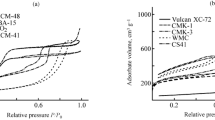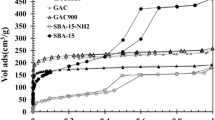Abstract
Chemisorption of oxygen on Spherocarb has been performed to determine the surface oxide formation and the initial adsorption rate of Spherocarb, at the temperature range of 360 K to 851 K and oxygen pressure range of 0.05 to 1 atmosphere respectively. The maximum amount of oxygen adsorbed is estimated to occupy 91.8 m2/gC or 10% of the total surface area (TSA). The rate of chemisorption of oxygen on Spherocarb is very rapid in the beginning but it slows down with coverage. The initial oxygen chemisorption data can be linearized when plotted as amount adsorbed vs.ln (time). The data can be fitted to the integrated form of the Elovich equation, which is q= l/b*ln(l + abt) where q is the amount adsorbed and a and b are constants. This equation is applicable to the adsorption data for a wide variety of systems. A study of the variation of oxygen up-take with temperature during the first minutes of chemisorption for Spherocarb has suggested that chemisorption is the rate-controlling process initially while diffusion of oxygen and the desorption of oxidation products rapidly assume control of the oxidation rate. The experimental results show that oxygen chemisorption has an activation energy between 12 Kcal/mole and 25 Kcal/mole. It can be modeled using the Elovich equation and the initial amount chemisorbed increases in direct proportion to carbon conversion.
Similar content being viewed by others
References
Aharoni, C. and Tompkins, F. C., “Advances in Catalysis”,21, 1 (1967).
Allardice, D. J., “The Adsorption of Oxygen on Brown Coal Char”.Carbon,4, 255 (1966).
Carpenter, D. L. and Sergent, G. D., “Initial Stages of Coal Oxidation III”.Fuel. 45, 311 (1966).
Cheng, A. and Harriot, P., “Kinetics of Oxidation and Chemisorption of Oxygen for Porous Carbons with High Surface Area”,Carbon. 24, 143 (1986).
Floess, J. K., Lee, K. J. and Oleksy, S. A., “Kinetics of Oxygen Chemisorption on Microporous Carbons”.Energj and Fuels. 5, 133 (1991).
Floess, J. K., Oleksy, S. A. and Lee, K. J., “Low Temperature Oxidation Reaction of Microporous Carbons”,ACS Division of Fuel Chemistry Preprints. 34(1), 184 (1989).
Furimsky, E., Palmer, A., Duguay, D. G., McConnell, U. G. and Henson, D. E., “Characterization of Carbonaceous Solids by Oxygen Chemisorption”,Fuel,67, 798 (1988).
Khan, R., “Significance of Char Active Surface Area for Appraising the Reactivity of Low and High Temperature Chars”,ACS Division of Fuel Chemistry Preprints,34(1), 192 (1988).
Mentser, M. and Ergun, S.,Carbon. 5, 331 (1967).
Sevenster, P. G., “Studies on the Interaction of Oxygen with Coal in the Temperature Range 0° to 90°C”,Fuel,40, 7 (1961).
Sy, O. and Calo, J. M., preprint56b, AIChE Annual Meeting 1982.
Tucker, B. G. and Mulcahy, M. F. R., “Formation and Decomposition of Surface Oxide in Carbon Combustion”,Trans. Faraday Society,65, 274 (1969).
Author information
Authors and Affiliations
Rights and permissions
About this article
Cite this article
Lee, K.J., Han, I.H. & Choi, K.H. Oxygen chemisorption on microporous carbons: An analysis of experimental data. Korean J. Chem. Eng. 12, 228–235 (1995). https://doi.org/10.1007/BF02705651
Received:
Accepted:
Issue Date:
DOI: https://doi.org/10.1007/BF02705651




